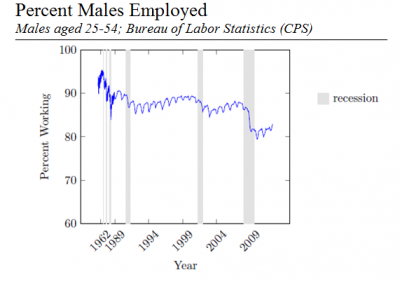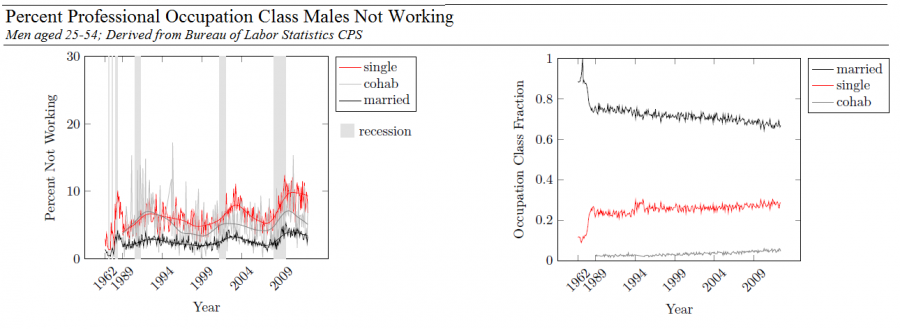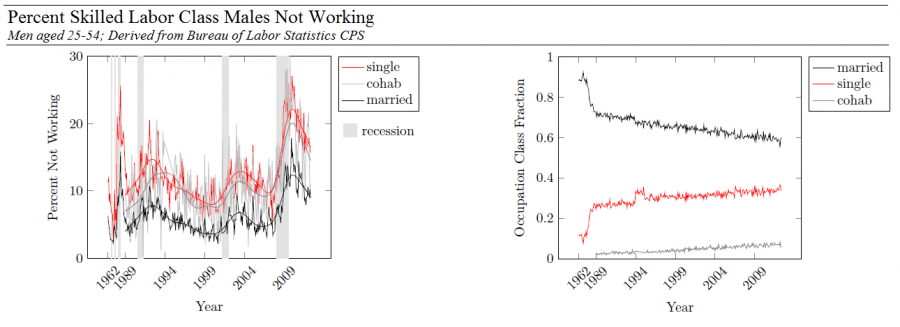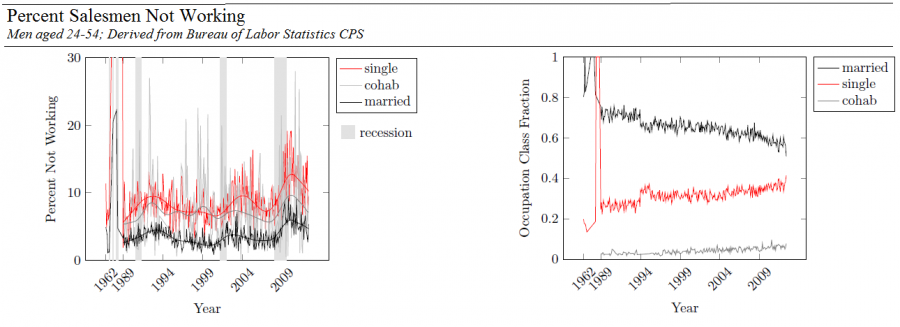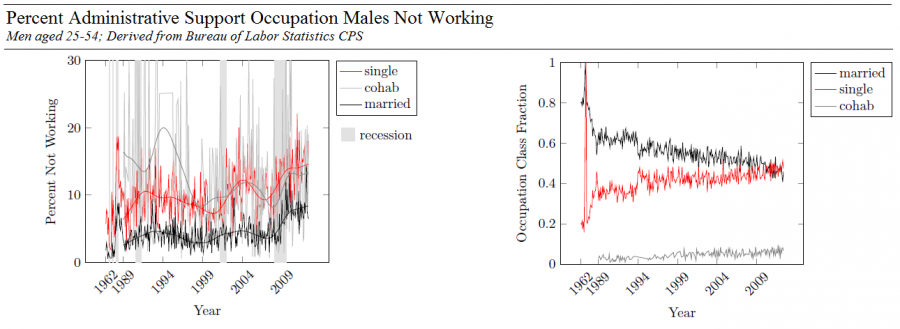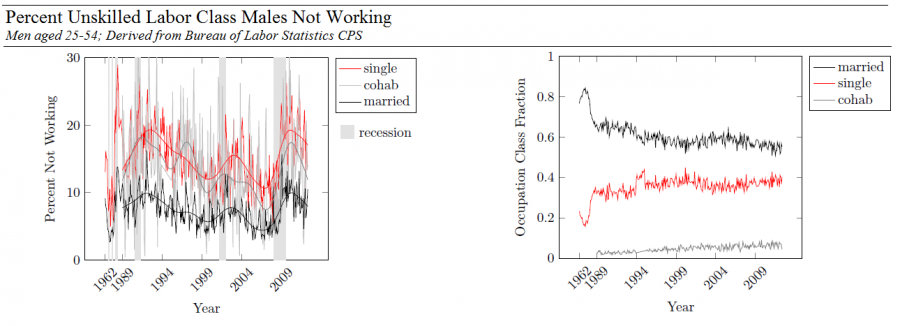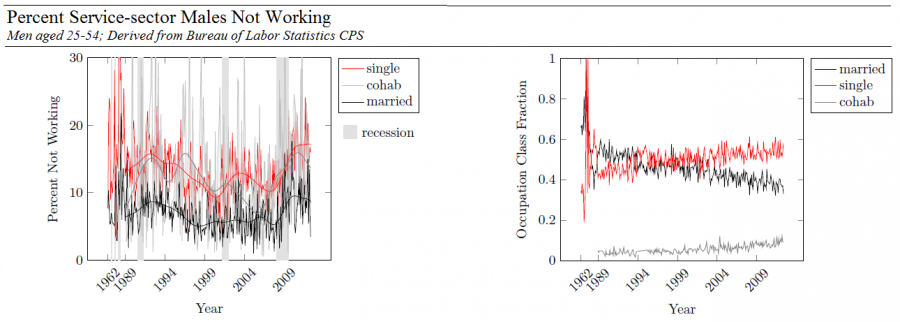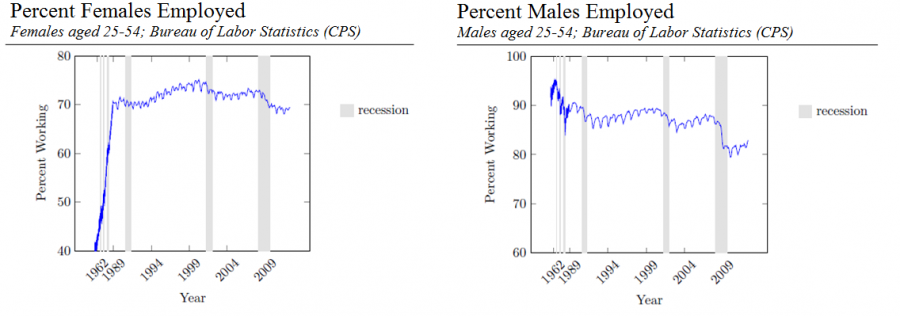Effects of Marriage on Labor Participation
Decreasing marriage trends can be causally associated with the decline of adult male labor participation. This withdrawal of able-bodied workers from productive employment amounts to the removal of one of the key components for domestic production at the macro-economic level.
1. Family Structure and Labor Patterns
Labor participation and the technical capacity of the workforce are the core factors of production that drop during a depression.1) The decline in adult male labor participation2) is associated with non-marriage trends within and across occupation classes3) of the U.S. population. Occupation type and education level4) are generally recognized specifiers5) of human capital.6)
As shown by the charts below, for all occupation classes and through myriad macro-economic changes, married men are consistently more employed than single or cohabiting men. There is a well-defined difference in the rate of not working for men of different marital statuses. This is the “gap” between the upper and lower curves in the left graphs below.
2. Effects of Marital Status on Labor Participation
Across all occupation classes in the charts above, a consistent and well-defined difference in rates of employment between men of different marital statuses persists (seen in the left graphs). All the while, the married state is consistently losing ground to singlehood and cohabitation (seen in the right graphs). It is the state of marriage that makes the men in these subpopulations be employed in much greater percentages, regardless of other qualities7) found in those men.
Marital state must affect behavior because the population is shifting from one marital state to another as the decades progress.8) If the same quality of man had merely moved from married to unmarried states, he would have brought his propensity to work with him. Had that happened, non-married men would see a relative increase in their group’s propensity to work. This increase did not happen, as shown in the charts above. The men who shifted from married to unmarried states took on a lower propensity to work in the process.
Likewise, if a sub-population of married men with a lower propensity to work were to move into the growing single and cohabiting population groups, the remaining married men should see their average propensity9) to work increase. This is not seen in the charts above, hence no such sub-population exists. The men shifted from married to unmarried states and took on a lower propensity to work through that transition. The abandonment of marriage caused this segment to reduce its labor participation.
3. Other Relevant Factors Affecting Labor Participation
3.1 Feminization of Labor
Women entering the workforce cannot adequately explain the lower level of labor participation by unmarried men (at least after 199010) as this process stabilized by the 1990s (see chart below). After this time male labor participation continued to fall off.11)
3.2 Globalization of Labor
The effects of globalization of the labor market cannot be an explanation for this lower level of labor participation as researchers have controlled for occupation class,12) and this relative employment difference holds irrespective of occupation class and its susceptibility to global competition.13)
3.3 Favoritism of the Married Over the Single
Relative employment cannot be attributed to management favoritism of married men over singles. Two data are necessary to demonstrate this. First, note that because their human capital is more developed, married men earn more generally.14) Second, note how the gap’s width (between singles and married men, with cohabiting men in between) increases during recessions. Why? Especially during recessions, management acts to hold on to its most valuable labor, even though it is its most expensive labor. This is a general phenomenon: In depressions, lower-skilled labor is let go of first, and in massive quantity.15) It is single men that here are most identified with lower-skilled labor. Relative wage stickiness (i.e. the maintenance of relatively high wages during economic downturns) results as the higher-skilled and higher-paid employees are retained.
Labor patterns demonstrate that markets choose married men because they are, relative to all other groups, the most valuable.16)
The second datum above also shows that non-marriage creates economic insecurity for the whole nation: Compare the latest recession to the recession of the early 1980s. In both recessions each marital status group had similar employment responses, but the latest recession saw a further weakening of the overall workforce because the population that is married is smaller.
4. Non-Marriage Reduces Macro Labor Participation
American labor participation for men has been dropping off since the 1960s. Correspondingly, a “gap” exists between the participation rates of married men and unmarried men. This gap and the population shift towards non-marriage alone17) can immediately account for around half of this decrease in labor participation.18) 19)
5. Risk of a Depression
Entering into marriage affects economic agents’ behavior.20) The abandonment of marriage leads to reduced population21) with its eventual loss in human capital.22) This rejection of marriage is also cause for reduced labor participation. Together, these factors put the United States at risk of economic depression. The continuance of this cultural-demographic drift away from marriage and into household structures that are less productive and less engaged in the economy will exacerbate this risk over time.
A depression sees a fall-off of at least 20 percent from the potential GDP. This fall-off lasts for more than a decade, with most of the fall-off occurring before the first decade of the depression is out.
Professional occupations: accountants, chemists, professors, doctors, editors, engineers, lawyers, nurses, pharmacists, social workers, teachers, managers
Skilled labor occupation: technicians, carpenters, craftsman, mechanics and repairmen, plumbers, metal workers
Salesmen: all types except retail
Administrative support occupations: clerical secretaries, typists, bookkeepers, phone operators, office boys
Unskilled labor occupations: drivers, deliverymen, furnacement, assembly line workers, day laborers
Service-sector occupations: wait staff, housekeepers, retail salesmen.
